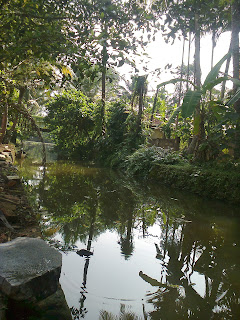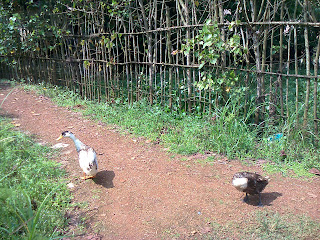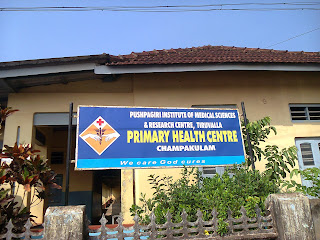The life of people in Kuttanaad is very characteristic of the region. It is governed primely by the natural landscape & the monsoons.
Landing in Kerala what catches the eye of a first timer are the many 'Kurushadi' s that seem to be just about everywhere. These "'Kurushadi's or towers are an intrinsic part of the Christian culture characteristic of the region. They serve as both a proclamation of faith as well as important landmarks. They house statues of saints, prophets, Jesus Christ, Mother Mary and their like.In some cases as is commonly seen these days statues of Hindu gods, goddesses or social reformers like Sree Narayana guru are also being placed in them.
 |
| A 'kurushadi' dedicated to St. Thomas welcomes visitors to the St. Mary's church at Champakulam. |
Surrounded by water and with no attractions like shopping or night life that a city might offer the
people while away their time chatting under shady places like this particularly recent one offered by the new flyover.
people while away their time chatting under shady places like this particularly recent one offered by the new flyover.
 |
| Two elderly men take a break as my brother joins in momentarily. |
Hospitals and health amenities are quite poor in these parts compared to the nearby towns. The primary health center here, is run by the Pushpagiri Institute of Medical Sciences & Research center at Tiruvalla.
With such meager amenities available to the locals, the only alternative before them remains the faraway hospitals and shopping complexes. They spend half a the lifetime waiting for ferries that are irregular and unpredictable.
 |
| A lady waiting for a boat to take her to the town on the opposite bank. |
A common sight in these parts are women washing clothes on the edges of the canal. The flowing waters are sure to carry away the dirt and thus are do not accumulate. Even so, years of using the canal like this has taken its toll and its no longer as good as it once used to be. At one time, my mother vouched that the water as the sole source of water to the cut off land. Once boiled, it was fit for drinking too. Today, no one would even imagine attempting that.
 |
| Two ladies chat away as they wash clothes on the edge. |
Paths like these originate at the banks and take travelers to the interiors of the loner's paradise. Being a prime rice bowl for the homeland they are basically an agricultural community. As everyone knows everybody else, paths like these often find neighbors and friends chatting away for hours at the slightest gesture of familiarity. Perhaps that is what makes the people so tightly bonded to each other. Not when though, if you have quarrelsome neighbor. :)
 |
| Women share a friendly chat irrespective of the blistering sun. |
When it is not time for either sowing or reaping the land is left untended. It becomes a pasture , a welcome sight to the locals and visitors alike.
 |
| Untended but lush. |
There are all ranges of people here, though most are poor. The very rich are here looking out for a paradise-like recluse away from towns while the poor are there because there is no place else to go. There is another middle group with fathers, uncles and aunts in 'the gulf' and who are reasonably well off on the money sent to them. They ave managed to build attractive houses by the water front.
 |
| A relatively new water front house. |
Many little canals like these weave in and out of most plots. They offer the perfect cool shade for swimming, bathing and washing clothes.
 |
| A stone is laid on which clothes can be washed. |
Now most of the water is overgrown with water lilies and hyacinths. Consequently the women have found ways to draw away water without having to clear away the plants every single time. They put in wooden posts into the water and the little area is netted. I found the idea simple, ingenious and attractive.
 |
| Cut off to beauty. |
The income from agriculture is often too little to meet most needs around the house. To ensure that their children get enough protein women rear ducks, geese, fowl and cattle.
 |
| A gander turns back as his lady love orders him to follow. At least, 'that' is universal :) |
Agriculture is not just an occupation to the people. it is a passion. Most plots of land are small and yet the people have taken care to plant plants where ever possible.
 |
| I found this less common plant basking in the sun beside a doorstep. |
Such little aspects of the people of Kuttanaad are quite characteristic of them. They have over the years learnt to live in harmony with water and whatever hardships living in a drought & flood prone area like Kuttanaad decks out. Though many are migrating to better accessible areas the few who remain still hold on with fond memories of ancestors and of drowned children.


